Why do cucumber leaves turn pale
Why do cucumber leaves turn pale? Many gardeners are faced with this problem. Let's consider the main causes and options for eliminating the problem
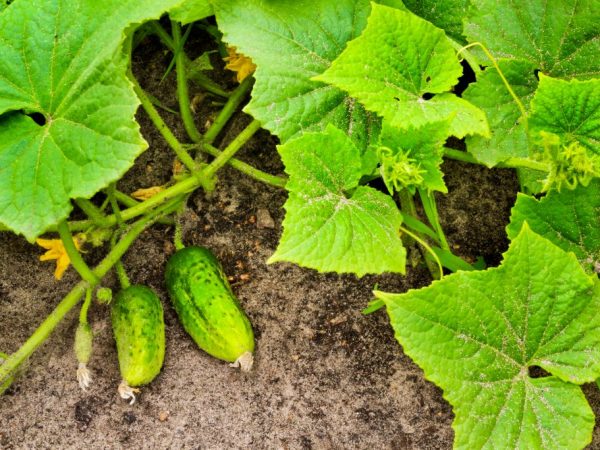
Causes of pale cucumber leaves
Lack of minerals
One of the main reasons why cucumber leaves turn pale is a lack or, conversely, an excess of certain minerals and trace elements in the soil.
Basically, a violation of this balance affects the quality and presentation of the fruit, and also impairs the growth of bushes. Leaves turn pale most often due to a lack of nitrogen, magnesium, iron, calcium, phosphorus, potassium, copper and manganese.
Nitrogen
The lack of this element affects not only the blanching of the foliage, but also the development and modification of the entire plant:
- lateral lashes and leaves are poorly formed;
- inflorescences fall;
- no green ovary is formed;
- yellow spots appear on already mature leaves.
The leaves turn pale, later turn yellowish, then completely darken. The very first to get sick are the leaves from below. Insufficient nitrogen can be recognized by the green streaks on the leaves. They retain their color almost until they fall off.
Treatment
It is necessary to timely apply nitrogen fertilization to the soil. You can also feed with a solution of mullein with water (1 liter of mullein per 10 liters of water), 1 liter for each plant.
Magnesium
Magnesium deficiency can be recognized by the following signs
- leaves turn pale below;
- the plant stops growing.
The first signs of paleness are visible between the veins, then closer to them, and then the color spreads throughout the plant. After that, the cucumbers acquire a lilac or maroon color along the edges of the leaf plates.
Treatment
The plant needs constant foliar feeding with magnesium nitrate in the ratio of 100 g of the drug to 10 liters of clean water.
Iron
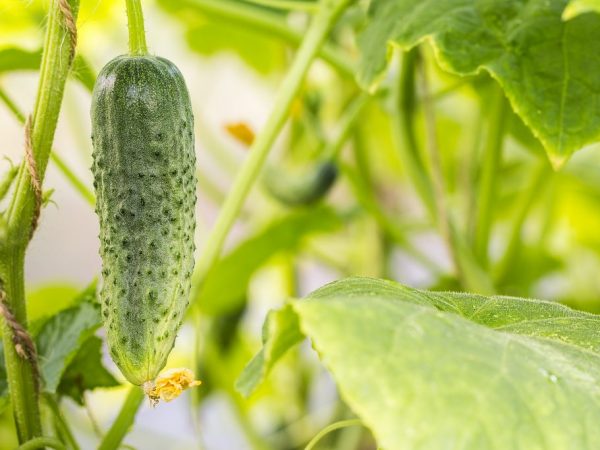
With a lack of iron, the plant needs root feeding with iron sulfate.
With a deficiency of this mineral, the rate of photosynthesis decreases. Also, a plant (especially a young one) loses color, starting from the top. If the problem is not resolved in a timely manner, this will entail:
- drying of leaves at the edges;
- cessation of the growth of a young leaf.
Loss of green color begins soon in mature leaves. The lack of iron does not affect the yield and the quality of fruiting, but the growth and flowering of the bush slows down.
Treatment
The plant needs root feeding with iron vitriol (5% solutions) or foliar fertilization with a soapy solution from an ash extract.
Calcium
Mature leaves do not respond to a lack of calcium, in contrast to young leaves, which have a rich dark color. With a lack of calcium:
- foliage turns pale in stripes;
- bends downward.
Treatment
Foliar application is required with a 3% solution of chelated calcium.
Phosphorus
With a lack of phosphorus:
- dry spots are formed on the lower leaves;
- the bush slows down in growth, or even stops growing altogether;
- ovary and flowers crumble.
Treatment
Drip irrigation is carried out with phosphorus-potassium fertilizer.
Potassium
If it is noticeable that a light border has formed on the leaves, and the shoots began to wither quickly, the plant has a potassium deficiency.
Treatment
The leaves are treated with soapy water with the addition of potassium permanganate (5%). Also, watering the plant with a solution of ash (1 tbsp. Ash per 10 liters of water) is carried out with the calculation of 1 liter of the prepared solution for one plant.
Copper
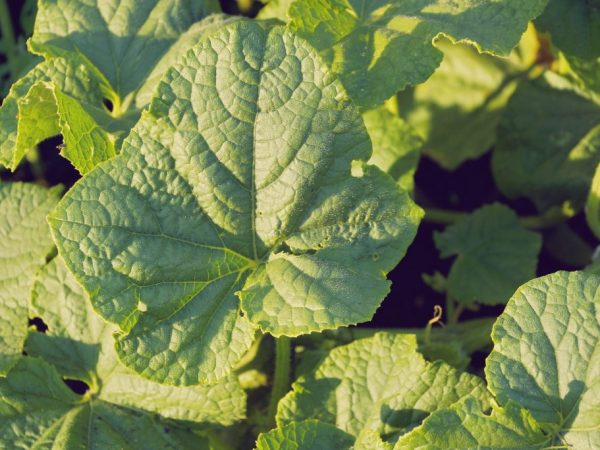
Lack of copper is detrimental to the plant
With a copper deficiency, the leaves become noticeably pale, the shoots wither, and the flowers quickly crumble even before the ovary is formed. It all starts with light green, and then almost colorless tops of the leaves.
Treatment
Leaf processing with copper sulfate (5%) during the growing season. Also, for prevention, in the spring, at the place where the cultivation of cucumbers is planned, a solution of the same copper sulfate (1%) is introduced into the soil, which also helps in the fight against various types of fungal diseases.
Manganese
With a deficiency of manganese:
- light dotted spots appear over the entire surface of the leaves;
- the tissue near the veins begins to turn yellow;
- the edges of the leaves are colored orange or even rusty.
Treatment
The plant needs root dressing with a manganese solution in a ratio of 3 mg of the drug per 1 liter of water, under each bush.
Frostbite
It happens that after the onset of sudden frosts, the leaves turn pale or their complete discoloration is noticeable.
Sometimes this does not occur over the entire surface of the sheet plate, but only on its individual parts. These pale spots look like water streaks, sometimes lighter or darker.
Treatment
Remove all damaged leaves, as well as the most damaged shoots, if any.
Diseases
Most often, cucumbers in the greenhouse are exposed to diseases. Humidity only contributes to the spread of both viral and fungal infections.
It is necessary to constantly air and temper the seedlings.
Mosaic disease
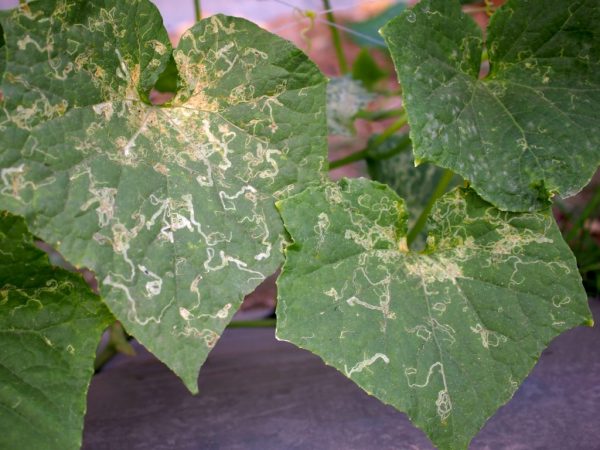
Diseased leaves need to be removed
The disease affects both greenhouse cucumbers and those growing in the open field. A pale yellow dot pattern forms on the leaves, after which the leaves curl and the edges roll up. The reason for the spread is the planting of infected seed.
Treatment
You can get rid of the disease only by removing the infected plant area. The rest, not yet infected, are sprinkled with low-fat milk (1%). It is advisable to burn infected bushes away from the garden.
Powdery mildew
A whitish bloom is formed on the leaves, reminiscent of lime stains. The disease affects open field cucumbers. Most often, the first signs appear after rain or dampness. Plaque can cover not only cucumbers, but also other crops growing nearby.
Treatment
The bushes are treated with mullein and urea (the proportion of the solution is 1 x 50).
Peronosporosis
Symptoms of the disease are similar to powdery mildew, but a yellowish bloom is at the top of the leaf, at the bottom it is gray. If measures are not taken in a timely manner, the spots will darken, and the leaves will deform and dry out. The reasons may be uneven watering, temperature drops, cold water.
Treatment
Watering should be limited or even stopped. All damaged leaves are completely removed, and all bushes are treated with Oxyhom. The solution is prepared in the proportion of 2 tablets per 10-12 liters of water.
Root rot
This type of fungus first affects the roots, and then the lower part of the plant, after which it rises up. The leaves turn pale, after which the whole liana dies off.
The cause of the disease is uneven watering, planting density, which causes rapid infection, as well as high humidity (in the greenhouse).
Treatment
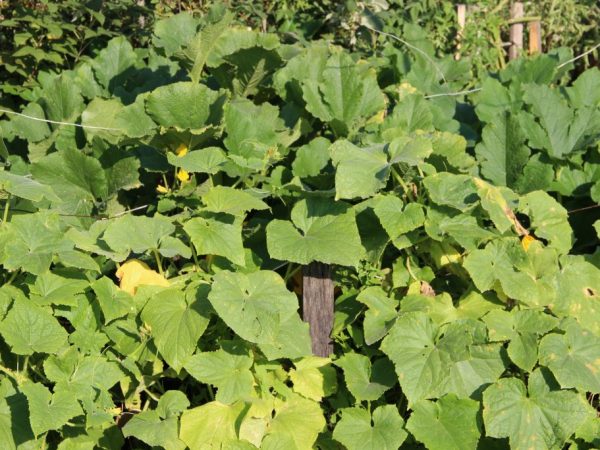
Root rot can destroy all plants
Pale leaves must be removed, and the affected bushes must be treated with a solution of Infinity 61 SC.
White rot
White rot is another cause of pale cucumber leaves.The first sign of a fungus is the appearance of jelly-like, weeping spots near the roots, on which white fluff soon appears. The fungus spreads throughout the plant, affects the shoots, and then the leaves.
Treatment
First, the infected areas are removed. When the affected part of the bush is not very large, it is sprinkled with a mixture of crumbs of chalk and lime. Plants completely affected by the disease are removed.
Pests
Pests also often cause pale spots on cucumber leaves.
Spider mite
First, the leaves of cucumbers turn pale, then turn yellow, then dry out. A cobweb is visible at the bottom of the leaf.
Treatment
Treat with a decoction or infusion of dandelions and wormwood. You can also use drugs:
- Actellik;
- Fitoveri;
- "Acaricide";
- "Agavertin".
Thrips
The affected parts of the cucumbers, after they have turned pale and lost color, die off.
Treatment
Spray with strong onion infusion, then process:
- "Aktaroy";
- "Ram";
- "Karbofos";
- "Decis";
- "Selion".
Nematodes
Specifically, a pale surface of leaves with yellowness, which is also characterized by deformed parts of the bush, most often dwarfism.
Treatment
Affected plants are best destroyed. To protect the bushes that have not yet been affected, a formalin solution or 96% Bordes liquid is used.
Watering mode
The reason why the leaves of cucumbers turn pale may be a lack of moisture in the soil or the use of cold water for irrigation. It is necessary to form a regular irrigation schedule using separated and warmed water.
Excess ovary
A huge number of ovaries draws out all the vitality of the plant, as a result, cucumber bushes become lethargic and lose color saturation. A certain amount of fruits is harvested, distributing them evenly over the liana, according to the principle of decreasing, upward.
Conclusion
The problem under consideration may be associated with an excess or lack of minerals, lighting and watering regimes, diseases and pests, or with an unsuccessful selected seed variety. A good option is to choose a complex fertilizer that protects the cucumbers, as well as taking care of the required amount of trace elements in the soil. Also, prophylaxis against pests is carried out in advance in order to get a healthy harvest.


